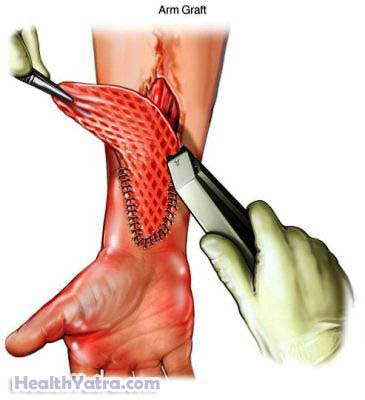Definition
A skin graft surgery is the removal and transplantation of healthy skin from one area of the body to another area. It is done to replace the skin in an area where the skin has been damaged. The source sites most commonly used for skin grafts are the inner thigh, buttocks, below the collar bone, in front of and behind the ear, and the upper arm.
The use of your own skin as the source area is called an autograft. If there is not enough skin on the body to provide graft coverage, skin may be harvested from outside sources. These alternate sources are only meant for temporary use until your own skin grows back. Three common options are:
- Allograft—skin taken from another human source, such as a cadaver
- Xenograft—skin taken from an animal source
- Synthetic tissue
Reasons for Procedure
- To promote healing of:
- Large burns
- Wounds
- Venous ulcers
- Pressure ulcers (bedsores)
- Diabetic ulcers
- To reconstruct skin removed during surgery (such as following breast cancer surgery)
A successful skin graft will result in transplanted skin adhering and growing into the recipient area. Cosmetic results may vary, based on factors such as the type of skin graft used and the recipient site.
Possible Complications
If you are planning to have a skin graft, your doctor will review a list of possible complications, which may include:
- Bleeding
- Graft failure
- Infection at either the donor or recipient site
- Poor healing
- Increased or decreased sensation at the recipient site
- Hair may not grow on recipient site
- Graft tissue of contracts, interfering with limb movement
Factors that may increase the risk of complications include:
- Age: newborns and infants, or 60 or older
- Smoking
- Diabetes
- Poor overall health
- Use of certain medicines
What to Expect
Prior to Procedure
The wound will be cleaned with an antiseptic.
Anesthesia
Depending on the surgery, you may receive:
- Local anesthesia—The immediate area is numbed.
- You may also be given intravenous drugs to help you relax and reduce anxiety.
- Regional anesthesia—A large area of your body will be numbed, but you will be awake.
- General anesthesia —You will be asleep.
Description of Procedure
The wound will be measured. A pattern of the wound will be traced and then outlined over the donor site. The donor tissue will be removed with a scalpel or special harvesting machine.
There are three main types of skin graft techniques:
- Split-thickness graft—This is the removal of the top layer of skin and part of the middle layer. This type of graft allows the source site to heal more quickly. The graft is more fragile. It may also be abnormally pigmented (color differences). This type of graft may be meshed. This is a technique which places multiple controlled holes in the graft. It will give it a mesh appearance. The mesh allows fluid to leak out from the underlying tissue bed. The meshed skin will be able to spread out over a much larger area of injury.
- Full-thickness graft—This is the removal and transfer of an entire area of skin. Although this type of graft requires stitches to heal the source site, the final outcome is usually better. Full-thickness grafts are usually recommended for areas where cosmetic appearance is important, such as the face. Full-thickness grafts can only be placed on areas of the body that have significant vascularization (blood vessels). Its use is somewhat limited.
- Composite grafts—This is a combination of skin and fat, skin and cartilage, or the middle layer of skin and fat. It is used in areas that require three-dimensionality, such as the nose.
The graft will be placed on the damaged site. It will be fastened with stitches or staples.
A pressure bandage will be applied over the area. A wound VAC may be placed for the first 3-5 days. This is a device that has suction and is used to control drainage. Initially, the graft will survive on oxygen and nutrients from the underlying tissue. Within 36 hours, new blood vessels begin to grow. New cells will grow from the graft to cover the damaged area with new skin.

How Long Will It Take?
This varies, depending on the size of the graft and extent and severity of the injury.
How Much Will It Hurt?
Harvesting skin grafts can be painful. Anesthesia should prevent most pain during the procedure. Talk to your doctor about medicine to help manage pain after the procedure.
Average Hospital Stay
This varies depending on the reason for the graft, the size of the graft, as well as other care that is needed. For example, recovery from a burn or accident may take longer.
Postoperative Care
Be sure to follow your doctor’s instructions , which may include:
- Keep the recipient site clean and dry.
- Avoid all trauma to the recipient site.
- Do not expose recipient site to prolonged sunlight.
- Inspect site for healing and good circulation, as shown by healthy pink coloration.
- Follow instructions given for bandaging the grafted area. This will provide the area with appropriate support during the healing process. It will also help to preventcontractures (intense tightening) even after healing is complete.
Call Your Doctor
After you leave the hospital, contact your doctor if any of the following occurs:
- Signs of infection, including fever and chills
- Redness, swelling, increasing pain, excessive bleeding, or discharge from the wounds
- Headache, muscle aches, dizziness, or general ill feeling
- Cough, shortness of breath, chest pain, or severe nausea or vomiting
- Any new symptoms
In case of an emergency, call for medical help right away.
